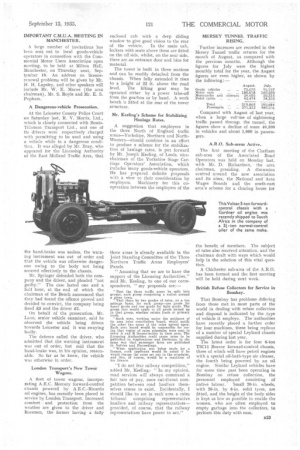IMPORTANT C.M.U.A. MEETING IN MANCHESTER.
Page 33

If you've noticed an error in this article please click here to report it so we can fix it.
A large number of invitations has been sent out to local goods-vehicle operators in connection with the Commercial Motor Users Association open meeting, to be held at Milton Hall, Manchester, on Thursday next, September 19. An address on licencerenewal problems will be given by Mr. H. H. Lapsley, and other speakers will include Mr. W. E. Macve (the area chairman), Mr. S. Royle and Mr. E. S. Popham, A Dangerous-vehicle Prosecution.
At the Leicester County Police Court on Saturday last, R. V. Morris, Ltd., which is closely connected with BoutsTillotson Transport Ltd., and one of its drivers were respectively charged with permitting to be used and using a vehicle while in a dangerous condition. It was alleged by Mr. Bray, who appeared for the Licensing Authority of the East Midland Traffic Area, that the hand-brake was useless, the warning instrument was out of order and that the vehicle was otherwise dangerous owing to the body not being secured effectively to the chassis, Mr. Springer defended both the company and the driver, and pleaded "not guilty." The case lasted one and a half hour, at the end of which the chairman of the Bench announced that they had found the offence proved and decided to convict, the company being fined £5 and the driver £1.
On behalf of the prosecution, Mr. Lane, senior vehicle examiner, said he observed the vehicle being driven towards Leicester and it was swaying badly.
The defence called the driver, who admitted that the warning instrument was out of order, but said that the hand-brake was, in his opinion, reasonable. So far as he knew, the vehicle was otherwise in order.
London Transport's New Tower Wagons.
A fleet of tower wagons, incorporating A.E.C. Mercury forward-control chassis powered by A.E.C.-Ricardo oil engines, has recently been placed in service by London Transport. Increased comfort . and protection from the weather are given to the driver and linesmen, the former having a fully enclosed cab with a deep sliding window to give good vision to the rear of the vehicle. In the main cab, lockers with seats above them are fitted on the off side, whilst, on the near side, there are an entrance door and bins for material.
The tower is built in three sections and can be readily detached from the chassis. When fully extended it rises to a height of 22 ft. above the road level. The lifting gear may be operated either by a power take-off from the gearbox or by hand. A work bench is fitted at the rear of the tower structure.
Mr. Keeling's Scheme for Stabilizing Haulage Rates.
A suggestion that employers in the three North of England traffic areas—Yorkshire, Northern and NorthWestern—should combine in an effort to produce a scheme for the stabilization of haulage rates, is put forward by Mr. Joseph Keeling, of Leeds, vicechairman of the Yorkshire Stage Carriage Operators' Association, which includes many goods-vehicle operators. He has prepared definite proposals with a view to their consideration by employers. Machinery for this cooperation between the employers of the three areas is already .available in the Joint Standing Committee of the Three Northern Traffic Areas Employers' Panels.
" Assuming that we are to have the support of the Licensing Authorities," said Mr. Keeling, to one of our correspondents, "my proposals are:— " That the three traffic areas be split into groups, each group comprising a radius around a given town. " That there be two grades of rates, on a ton mileage basis, for each group—one grade for heavy goods and one grade for light goods. The group rate would apply to all goods pirked up in that group, whether return loads or primary loads.
'Hach area, working under the guidance of its area joint conciliation board, would notify the other two areas ol the rates agreed upon. Each area board would be responsible for seeing that, cores of rates schedules were sent to every A an B licence-bolder in their area. The Licensing Authorities could cause rates to be published. in Applications and Decisions, in the same way that passenger fares are published in Notices and Proceedings.
When application was being made for a licence, each applicant would be asked if he would charge the rates set out in the schedules, and this, of course, would be a condition of his licence.
"I do not fear railway competition," added Mr. Keeling."In my opinion, road services will always command a fair rate of pay, once cut-throat competition between road hauliers themselves ceases to exist. Incidentally, I should like to see in each area a rates tribunal comprising representative hauliers and railway representatives— provided, of course, that the railway representatives have power to act."




















































































